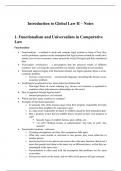Summary
Summary Introduction to Global Law II - complete notes for Global Law students
- Course
- Institution
Hello Global Lawyers! This document is a complete summary of the Introduction to Global Law II course for Global Law students at Tilburg University, and contains extensive summaries of all modules in the course. The summary was made drawing insights from readings, knowledge clips, and relev...
[Show more]



